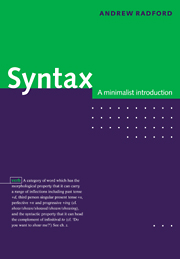Preface
Published online by Cambridge University Press: 05 June 2012
Summary
This book is essentially an abridged version of my Syntactic Theory and the Structure of English: a Minimalist Approach. Although much of the text of this shorter book is taken verbatim from various sections of the longer one, the shorter book is intended to be used as a self-contained introduction to syntax, and as such has been designed with a number of specific criteria in mind.
One is that lengthy tomes are simply impractical to use as coursebooks on short courses where only a limited number of hours/weeks are available: Joe Emonds once remarked to me that a student complained to him about my 625-page Transformational Grammar book that ‘This is the third syntax course I've been on where we only got halfway through the coursebook by the end of the course.’ The main text of the present book is around a third the length of the main text of Transformational Grammar and is designed explicitly to be used on short syntax courses. So, there's no excuse for not getting through all of it!
A second consideration which I have borne in mind is that students taking short introductory syntax courses want a general overview of key theoretical concepts and descriptive devices used in contemporary work in the 1990s; they do not want (nor is it realistic to give them) a historical account of how earlier work in the 1960s, 1970s and 1980s led up to (or compares with) current work.
- Type
- Chapter
- Information
- SyntaxA Minimalist Introduction, pp. vii - xPublisher: Cambridge University PressPrint publication year: 1997



